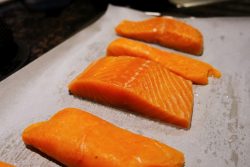 Did you know that the delicious farm-raised salmon on your plate might be hiding a secret? Recent research on over two metric tons of salmon from North America, South America, and Europe revealed some surprising findings. Farm-raised salmon were found with significantly higher levels of PCBs and other toxins when compared to wild salmon. This discovery raises concerns about the potential health risks of indulging in your favorite fish dish.
Did you know that the delicious farm-raised salmon on your plate might be hiding a secret? Recent research on over two metric tons of salmon from North America, South America, and Europe revealed some surprising findings. Farm-raised salmon were found with significantly higher levels of PCBs and other toxins when compared to wild salmon. This discovery raises concerns about the potential health risks of indulging in your favorite fish dish.
The production of farmed salmon has skyrocketed by 40 times in just two decades. This astounding leap can be credited to the sprawling salmon farms across Northern Europe, Chile, and North America, which now account for more than half the world’s salmon sales.
Although salmon is known for its numerous health benefits, there’s an untold story about the toxins they potentially accumulate. Salmon, being the fish predators they are, rank high on the food chain, making them prone to build-up of toxins in their bodies.
To gain a better understanding of the lives and diet habits of Pacific salmon, researchers have recently conducted an extensive study involving five wild species from three different regions in North America. For this research project, Chinook, Coho, chum pink and sockeye were all taken into consideration as scientists sought to uncover more information.
After an analysis of salmon samples was done, it revealed a fascinating pattern – farmed Atlantic salmon contained considerably higher amounts of 13 toxins when juxtaposed with their wild Pacific counterparts. Upon dissecting this discovery by geographical regions, it was observed that both European and North American farmed specimens exhibited substantial elevations in all 14 toxin levels in comparison to wild Pacific salmon. Intriguingly, South American farmed salmon only displayed increased levels of 6 toxins, and even demonstrated significantly reduced levels of two toxins (HCB and lindane) compared to wild salmon species.
The team delved into the world of farm-raised salmon and their diet, specifically “salmon chow” – a concoction of pulverized fish and oil. Unveiling a powerful link between the toxicity levels in chow and salmon, the study propounded that these menacing toxins find their way from the feed into the salmon, showing the journey of contaminants.
Farmed salmon carries a higher amount of toxins compared to their wild, open ocean counterparts. So, the next time you’re at the grocery store or your favorite seafood restaurant, pause and ponder. Do you want the economic benefits of farmed salmon or the healthy goodness of their wild counterparts?
To view the original scientific study click below:
Global Assessment of Organic Contaminants in Farmed Salmon





